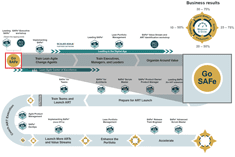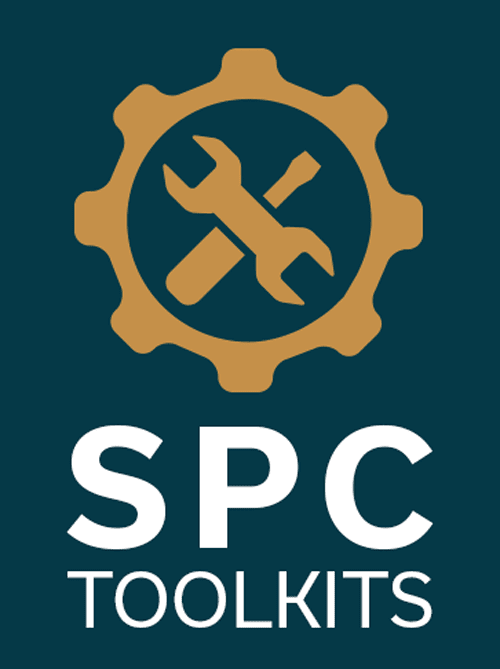
The success of any kind of social epidemic is heavily dependent on the involvement of people with a particular and rare set of social skills.
—Malcolm Gladwell, The Tipping Point
Reaching the Tipping Point
This is article one in the SAFe® Implementation Roadmap series. Click here to view the entire roadmap.
Changing the way of working in a large organization, including its habits and culture, is hard. Many enterprises report that implementing SAFe was one of the most challenging yet rewarding change initiatives they have ever done.
People naturally resist change, and it is common to hear phrases like, “That’s the way we’ve always done it around here” or “That won’t work here.” Accepting change means accepting the possibility that individuals and organizations are not currently doing things the best way, or it may even challenge a person’s long-held beliefs or values.
In the same way, people will naturally keep their old behaviors unless there is an exceptionally good motivation to make a change. This reason must be so compelling that the status quo becomes simply unacceptable. The motivation must be so strong that change becomes the only reasonable way forward to success.
In other words, the enterprise must reach its’ tipping point’—the point at which the overriding organizational imperative is to achieve the change rather than resist it [1].
Details
The Need for Change
Organizations arrive at the need for change from a wide range of starting points. The current context may be a highly controlled waterfall environment marked by strict phase gate reviews and quality checks, separation of concerns, and heavy resource management procedures. Or perhaps the organization has developed an ad hoc approach, mixing various team-level Agile methods with more traditional project and portfolio management techniques. Regardless, before a successful change effort can begin, there must be a clear and compelling impetus for change: a general acknowledgment that the current ways of working are inadequate to deliver the performance needed either now or in the future. Organizations that can establish such a shared awareness typically meet one of two conditions:
- A burning platform – Sometimes, the need to change a product or service is obvious. The company is failing to compete, and the existing way of doing business is obviously inadequate to achieve a new solution within a survivable time frame. Jobs are at stake. This is the more straightforward case for change. While there will always be those who are resistant, they will likely be overcome by the wave of energy that drives a sense of urgency for mandatory change through the organization.
- Visionary leadership – In the absence of a burning platform, leadership must drive change proactively by taking a stand for a better future state. Lean-Agile Leaders must exhibit what Toyota [2] would call “a constant sense of danger”—a never-ending sense of potential crisis that fuels continuous improvement. This is often the less apparent reason to drive change, as the people in the organization may not see or feel the urgency to do the additional hard work that comes with change. After all, they are successful now. Why should they assume they won’t continue to be successful in the future? Isn’t change risky? In this case, leaders must create a clear and compelling vision for change that answers why change is needed [3]. They must constantly communicate and impress the need for change on all, making it clear that maintaining the status quo is simply unacceptable.
In some instances, organizations have both a burning platform and visionary leadership with the courage to lead the change.
With SAFe as the blueprint for scripting the change, such organizations can experience a rapid and dramatic turnaround from a bleak crisis to strong, positive business results and a bright future.
Establish the Vision for Change
While necessary, a compelling and well-understood reason to change is insufficient for an organization to reach the tipping point. A clear vision for the future is also critical. Kotter notes that establishing a vision for change is a primary responsibility of leadership [4]. The vision for change provides three key benefits:
- Purpose – It clarifies the purpose and direction for the change and sets the mission for all to follow. It avoids potentially confusing details and focuses everyone on the change’s why not the how.
- Motivation – It starts to move people in the right direction. After all, change is hard, and pain is inevitable, especially in the early stages. People’s jobs will change. The vision helps motivate people by giving them a compelling reason to make the change. Perhaps most importantly, it underlines the fact there is no job security in the status quo.
- Alignment – It helps to start the coordinated action necessary to assure that hundreds, perhaps even thousands, of people work together toward a new and more personally rewarding goal.
With clarity of vision, people are more empowered to take the actions necessary to achieve the vision without the constant need for management supervision or check-ins. In the case of a SAFe transformation, the vision for change must be rooted in an understanding of the Lean-Agile Mindset and SAFe Principles. Leaders must also understand that how they lead directly correlates to whether or not employees buy into the change and contribute to its success. They must communicate within this vision the sense of urgency to the people they lead and their peers to obtain buy-in and commitment and generate more urgency through the organization.
Whether reactive or proactive, the primary reason to drive change in an organization is to realize the business and personal benefits the change intends to deliver. SAFe Principle #1 reminds us to ‘Take an economic view.’ In this context, leaders should articulate the goal of the change in terms everyone can understand. Case studies and customer stories show that enterprises can expect to see benefits in four major areas, as Figure 1 illustrates.
Change leaders should communicate these intended benefits as part of the vision for the change. In addition, leaders should describe any other specific, tangible objectives they hope to accomplish. This should include baseline metrics that illustrate the current state, why the current state is unsustainable, the target future state for the same metrics, and the strategy for how the change will achieve those targets. Measurable improvement on these key performance indicators will provide the fuel necessary to escape the inertia of the status quo.
Getting There – Leading SAFe
Establishing a vision for change is a crucial first step. But a vision alone is insufficient to reach the tipping point—that point where the evolving situation leads to an irreversible movement to the new way of working. Even in the presence of a vision for change, change efforts can stall in the face of organizational inertia unless supported by a senior leadership team with a shared rationale and commitment to the change.
A consistently effective way for organizations to reach the tipping point is the shared experience of leaders and key influencers who have attended Leading SAFe. While it can be challenging for senior leaders to commit to two days of dedicated time, evidence from hundreds of implementations demonstrates that this course is critical to establishing an aligned and committed approach to achieving the change. Leaders must take the time to collaboratively explore, analyze, and validate the organization’s challenges. They must evaluate how the current system contributes to those challenges and learn the mindset, principles, and practices they need to adopt to achieve the transformative results they envision. This experience also brings leaders together to align on how to move forward by scripting the critical moves necessary to realize the change vision.
Addressing SAFe Implementation in Government
A growing list of published case studies and experience reports (such as the Centers for Medicare and Medicaid and Pole emplôi) show that the principles and practices of SAFe work just as well in a government context as they do in a commercial setting. However, organizational context, culture, and governance challenges in public-sector programs are unique. Government acquisition processes and laws are intended to create a fair playing field among potential providers, but they can also create bureaucracy and delay. In addition, government agencies do not have the competitive market dynamic and profit motive that drives rapid change and innovation in a commercial environment. Instead, legislative bodies typically provide funding in politically-charged annual appropriations processes that move slowly. Even the concept of value in a government technology program is often difficult to conceptualize and measure.
To help government agencies get past the tipping point and make the decision to adopt SAFe, the SAFe for Government article series directly addresses the most frequent impediments to embracing Lean-Agile in government. It provides practical solutions for overcoming these challenges.
Moving Forward
A clear vision and compelling reason for change will not be adequate without a powerful guiding coalition and connected leadership to carry the vision forward [4]. The tipping point is just the start of forming that guiding coalition. Given a compelling reason to change, the next step is a commitment from leadership to build a transformation team, gain knowledge and explore possible pathways to launching the SAFe implementation, and become active learners of how to lead in today’s Digital Age.
Therefore, the next critical move is to Train Lean-Agile Change Agents.
This article serves as a launching pad to explore these steps in detail and understand how to apply them to specific implementations.
Learn More
[1] Gladwell, Malcolm. The Tipping Point: How Little Things Can Make a Big Difference. Little, Brown and Company, 2002.
[2] Cho, Fujio. Chairman of Toyota, 2006-2013.
[3] Sinek, Simon. Start with Why. Penguin Group, 2011.
[4] Kotter, John P. Leading Change. Harvard Business Review Press, 2012.
Additional Resources
SPCs have access to Executive Workshop Toolkit which assists in aligning executive stakeholders on the problems to be solved while developing a mutual understanding of what it means to be a Lean-Agile Enterprise. Learn more about the toolkit.
Last Update: 14 March 2023
